Employment Law Case Study: Employee Rights and Discrimination
VerifiedAdded on 2022/08/30
|14
|3760
|19
Case Study
AI Summary
This assignment presents two employment law case studies. The first case study involves Lila Bates (LB), a non-league football referee, and examines her employment status, religious discrimination, and potential discrimination based on disability within the context of the Equality Act 2010 and the Employment Rights Act 1996. The second case study addresses unfair dismissal, constructive dismissal, and wrongful dismissal. It explores the circumstances under which an employee can be considered to have been unfairly dismissed, the grounds for such dismissal, and the legal remedies available. The assignment analyzes the rights and obligations of both employers and employees, focusing on legal principles related to employment contracts, discrimination, and fair treatment in the workplace, including relevant case law.
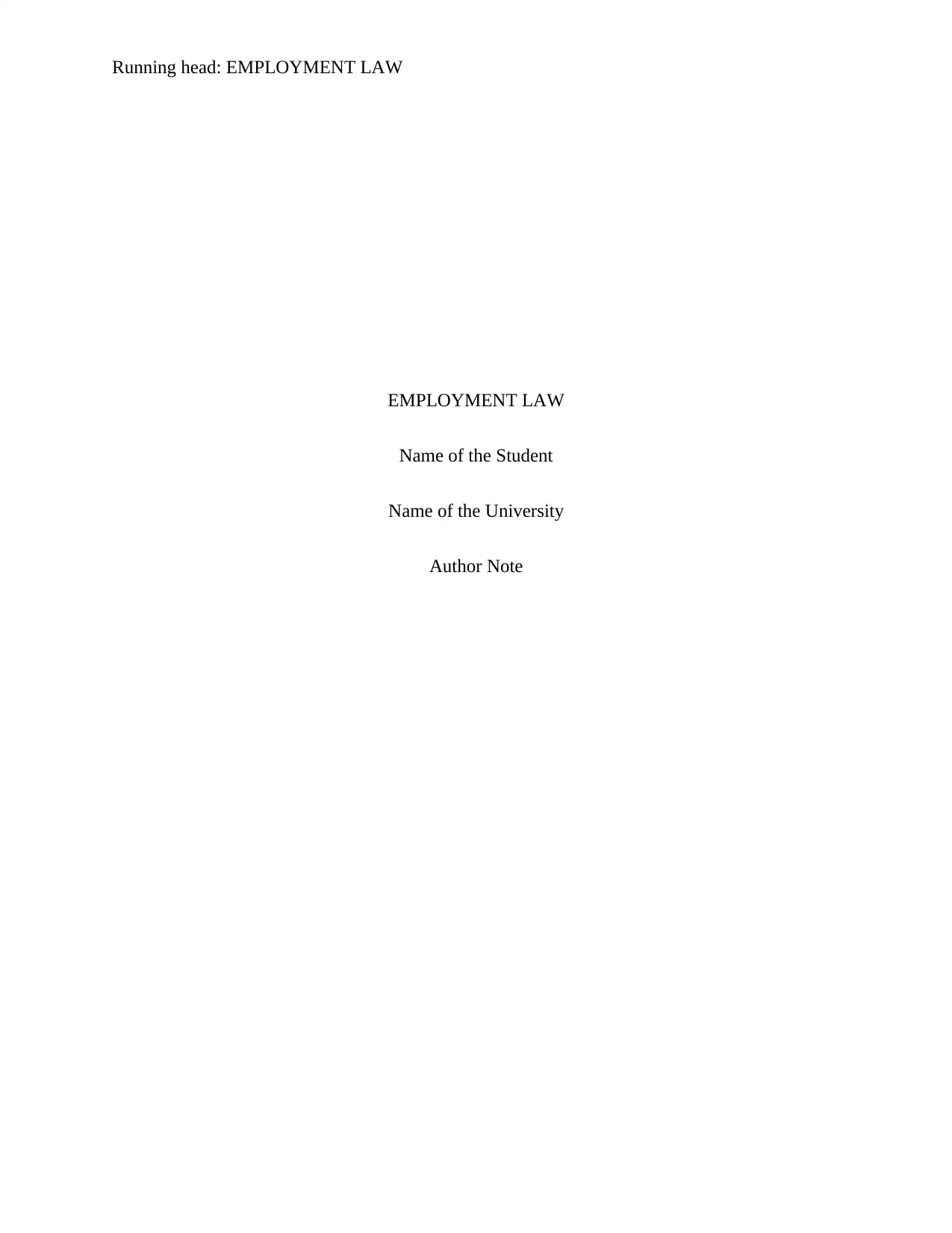
Running head: EMPLOYMENT LAW
EMPLOYMENT LAW
Name of the Student
Name of the University
Author Note
EMPLOYMENT LAW
Name of the Student
Name of the University
Author Note
Paraphrase This Document
Need a fresh take? Get an instant paraphrase of this document with our AI Paraphraser
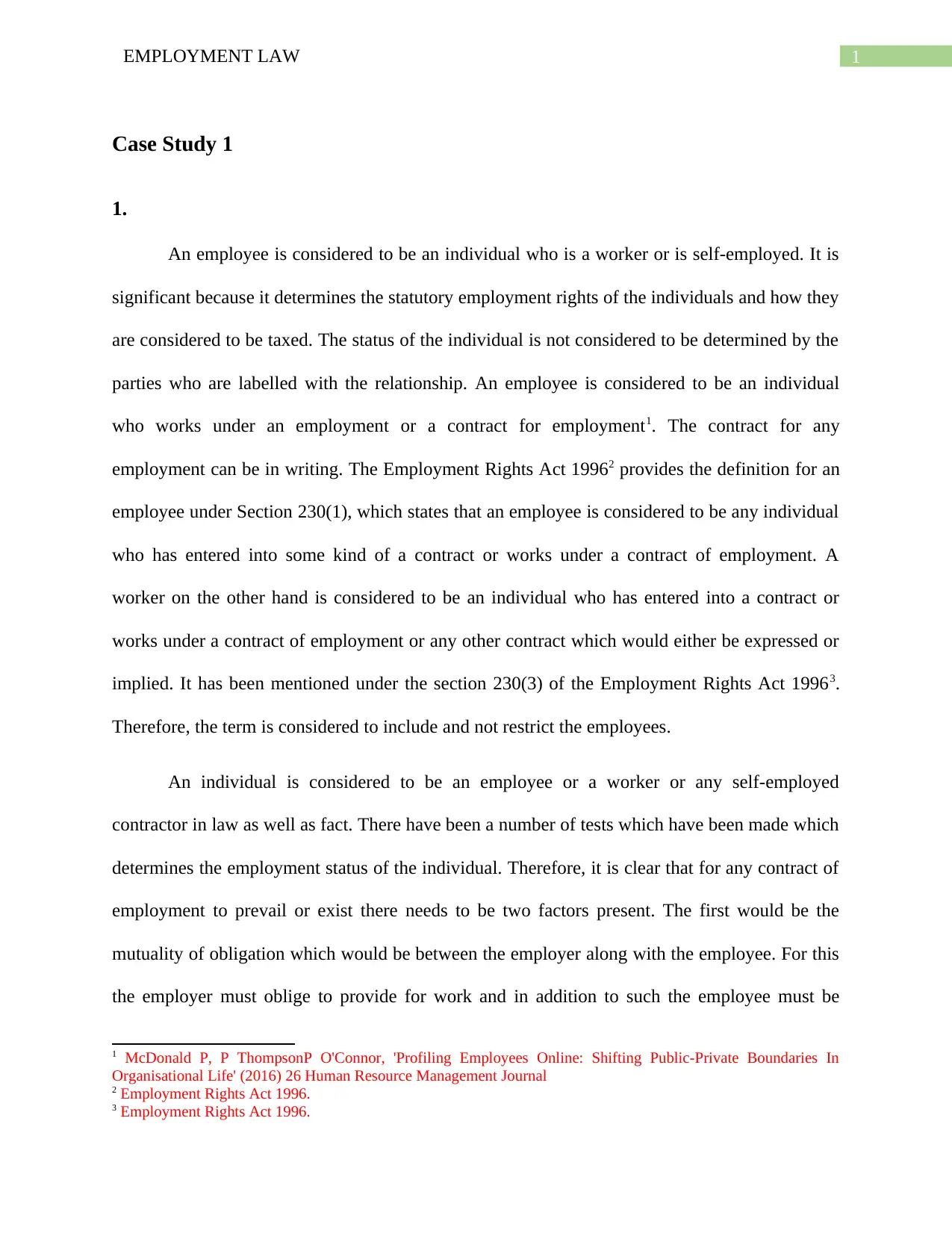
1EMPLOYMENT LAW
Case Study 1
1.
An employee is considered to be an individual who is a worker or is self-employed. It is
significant because it determines the statutory employment rights of the individuals and how they
are considered to be taxed. The status of the individual is not considered to be determined by the
parties who are labelled with the relationship. An employee is considered to be an individual
who works under an employment or a contract for employment1. The contract for any
employment can be in writing. The Employment Rights Act 19962 provides the definition for an
employee under Section 230(1), which states that an employee is considered to be any individual
who has entered into some kind of a contract or works under a contract of employment. A
worker on the other hand is considered to be an individual who has entered into a contract or
works under a contract of employment or any other contract which would either be expressed or
implied. It has been mentioned under the section 230(3) of the Employment Rights Act 19963.
Therefore, the term is considered to include and not restrict the employees.
An individual is considered to be an employee or a worker or any self-employed
contractor in law as well as fact. There have been a number of tests which have been made which
determines the employment status of the individual. Therefore, it is clear that for any contract of
employment to prevail or exist there needs to be two factors present. The first would be the
mutuality of obligation which would be between the employer along with the employee. For this
the employer must oblige to provide for work and in addition to such the employee must be
1 McDonald P, P ThompsonP O'Connor, 'Profiling Employees Online: Shifting Public-Private Boundaries In
Organisational Life' (2016) 26 Human Resource Management Journal
2 Employment Rights Act 1996.
3 Employment Rights Act 1996.
Case Study 1
1.
An employee is considered to be an individual who is a worker or is self-employed. It is
significant because it determines the statutory employment rights of the individuals and how they
are considered to be taxed. The status of the individual is not considered to be determined by the
parties who are labelled with the relationship. An employee is considered to be an individual
who works under an employment or a contract for employment1. The contract for any
employment can be in writing. The Employment Rights Act 19962 provides the definition for an
employee under Section 230(1), which states that an employee is considered to be any individual
who has entered into some kind of a contract or works under a contract of employment. A
worker on the other hand is considered to be an individual who has entered into a contract or
works under a contract of employment or any other contract which would either be expressed or
implied. It has been mentioned under the section 230(3) of the Employment Rights Act 19963.
Therefore, the term is considered to include and not restrict the employees.
An individual is considered to be an employee or a worker or any self-employed
contractor in law as well as fact. There have been a number of tests which have been made which
determines the employment status of the individual. Therefore, it is clear that for any contract of
employment to prevail or exist there needs to be two factors present. The first would be the
mutuality of obligation which would be between the employer along with the employee. For this
the employer must oblige to provide for work and in addition to such the employee must be
1 McDonald P, P ThompsonP O'Connor, 'Profiling Employees Online: Shifting Public-Private Boundaries In
Organisational Life' (2016) 26 Human Resource Management Journal
2 Employment Rights Act 1996.
3 Employment Rights Act 1996.
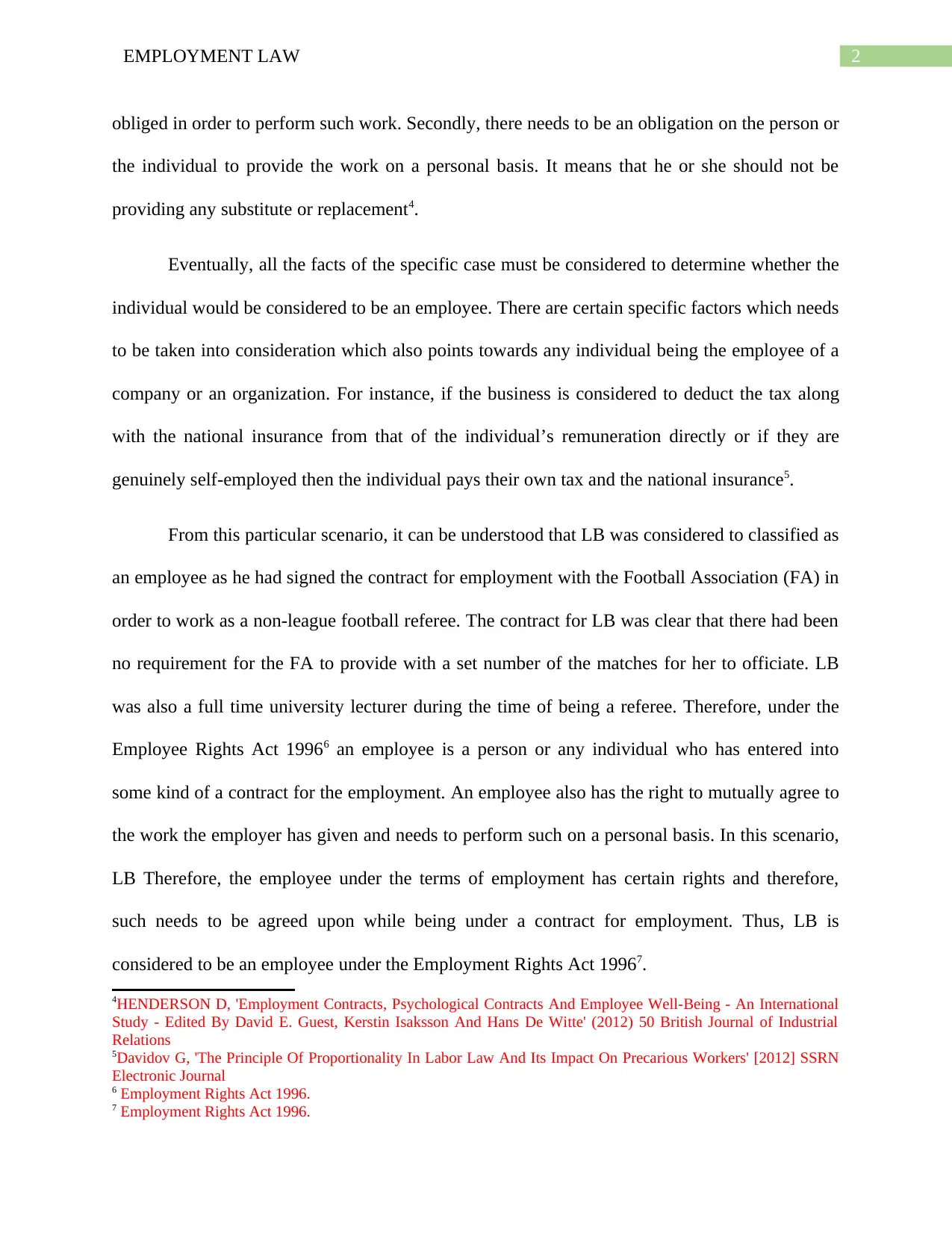
2EMPLOYMENT LAW
obliged in order to perform such work. Secondly, there needs to be an obligation on the person or
the individual to provide the work on a personal basis. It means that he or she should not be
providing any substitute or replacement4.
Eventually, all the facts of the specific case must be considered to determine whether the
individual would be considered to be an employee. There are certain specific factors which needs
to be taken into consideration which also points towards any individual being the employee of a
company or an organization. For instance, if the business is considered to deduct the tax along
with the national insurance from that of the individual’s remuneration directly or if they are
genuinely self-employed then the individual pays their own tax and the national insurance5.
From this particular scenario, it can be understood that LB was considered to classified as
an employee as he had signed the contract for employment with the Football Association (FA) in
order to work as a non-league football referee. The contract for LB was clear that there had been
no requirement for the FA to provide with a set number of the matches for her to officiate. LB
was also a full time university lecturer during the time of being a referee. Therefore, under the
Employee Rights Act 19966 an employee is a person or any individual who has entered into
some kind of a contract for the employment. An employee also has the right to mutually agree to
the work the employer has given and needs to perform such on a personal basis. In this scenario,
LB Therefore, the employee under the terms of employment has certain rights and therefore,
such needs to be agreed upon while being under a contract for employment. Thus, LB is
considered to be an employee under the Employment Rights Act 19967.
4HENDERSON D, 'Employment Contracts, Psychological Contracts And Employee Well-Being - An International
Study - Edited By David E. Guest, Kerstin Isaksson And Hans De Witte' (2012) 50 British Journal of Industrial
Relations
5Davidov G, 'The Principle Of Proportionality In Labor Law And Its Impact On Precarious Workers' [2012] SSRN
Electronic Journal
6 Employment Rights Act 1996.
7 Employment Rights Act 1996.
obliged in order to perform such work. Secondly, there needs to be an obligation on the person or
the individual to provide the work on a personal basis. It means that he or she should not be
providing any substitute or replacement4.
Eventually, all the facts of the specific case must be considered to determine whether the
individual would be considered to be an employee. There are certain specific factors which needs
to be taken into consideration which also points towards any individual being the employee of a
company or an organization. For instance, if the business is considered to deduct the tax along
with the national insurance from that of the individual’s remuneration directly or if they are
genuinely self-employed then the individual pays their own tax and the national insurance5.
From this particular scenario, it can be understood that LB was considered to classified as
an employee as he had signed the contract for employment with the Football Association (FA) in
order to work as a non-league football referee. The contract for LB was clear that there had been
no requirement for the FA to provide with a set number of the matches for her to officiate. LB
was also a full time university lecturer during the time of being a referee. Therefore, under the
Employee Rights Act 19966 an employee is a person or any individual who has entered into
some kind of a contract for the employment. An employee also has the right to mutually agree to
the work the employer has given and needs to perform such on a personal basis. In this scenario,
LB Therefore, the employee under the terms of employment has certain rights and therefore,
such needs to be agreed upon while being under a contract for employment. Thus, LB is
considered to be an employee under the Employment Rights Act 19967.
4HENDERSON D, 'Employment Contracts, Psychological Contracts And Employee Well-Being - An International
Study - Edited By David E. Guest, Kerstin Isaksson And Hans De Witte' (2012) 50 British Journal of Industrial
Relations
5Davidov G, 'The Principle Of Proportionality In Labor Law And Its Impact On Precarious Workers' [2012] SSRN
Electronic Journal
6 Employment Rights Act 1996.
7 Employment Rights Act 1996.
⊘ This is a preview!⊘
Do you want full access?
Subscribe today to unlock all pages.

Trusted by 1+ million students worldwide
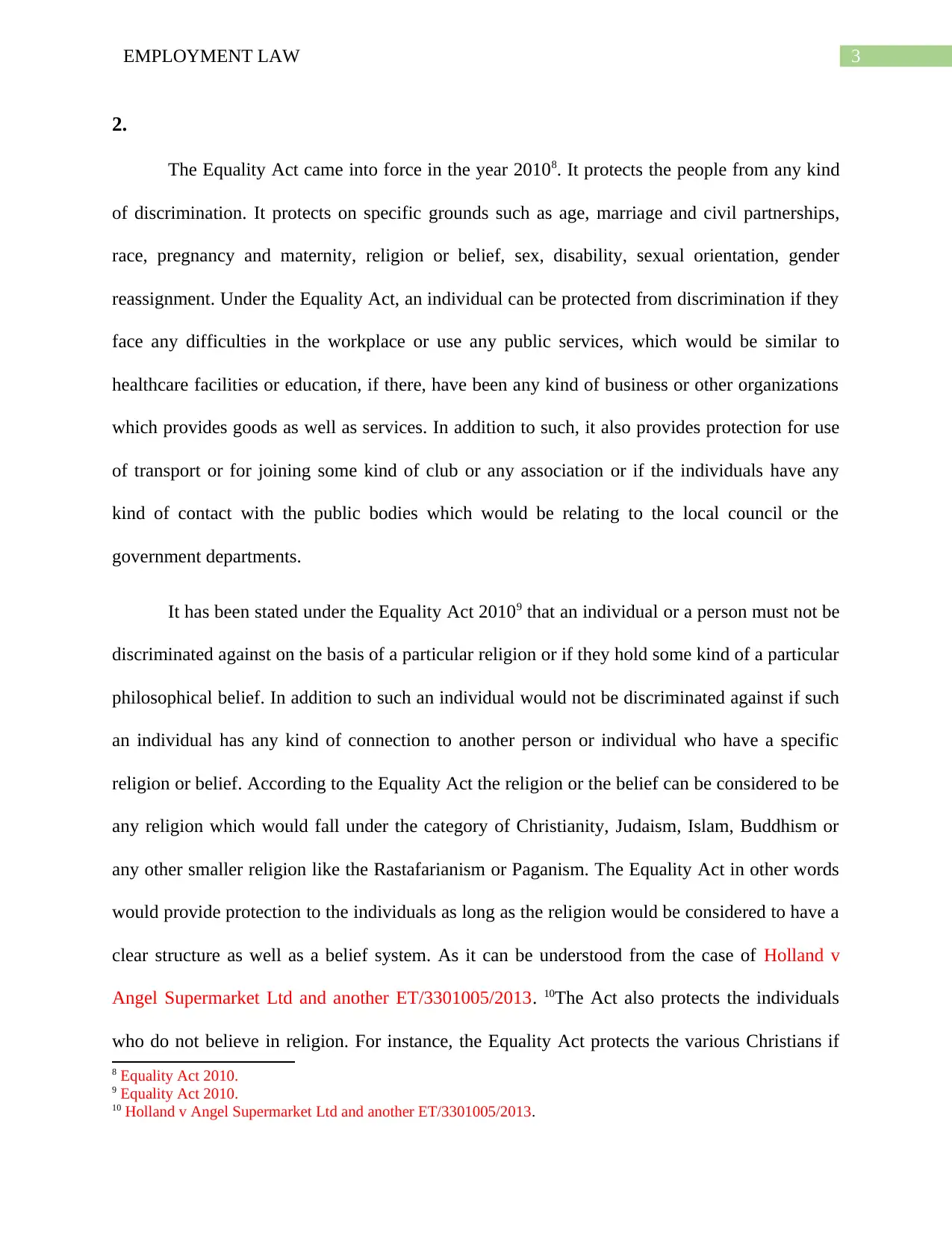
3EMPLOYMENT LAW
2.
The Equality Act came into force in the year 20108. It protects the people from any kind
of discrimination. It protects on specific grounds such as age, marriage and civil partnerships,
race, pregnancy and maternity, religion or belief, sex, disability, sexual orientation, gender
reassignment. Under the Equality Act, an individual can be protected from discrimination if they
face any difficulties in the workplace or use any public services, which would be similar to
healthcare facilities or education, if there, have been any kind of business or other organizations
which provides goods as well as services. In addition to such, it also provides protection for use
of transport or for joining some kind of club or any association or if the individuals have any
kind of contact with the public bodies which would be relating to the local council or the
government departments.
It has been stated under the Equality Act 20109 that an individual or a person must not be
discriminated against on the basis of a particular religion or if they hold some kind of a particular
philosophical belief. In addition to such an individual would not be discriminated against if such
an individual has any kind of connection to another person or individual who have a specific
religion or belief. According to the Equality Act the religion or the belief can be considered to be
any religion which would fall under the category of Christianity, Judaism, Islam, Buddhism or
any other smaller religion like the Rastafarianism or Paganism. The Equality Act in other words
would provide protection to the individuals as long as the religion would be considered to have a
clear structure as well as a belief system. As it can be understood from the case of Holland v
Angel Supermarket Ltd and another ET/3301005/2013. 10The Act also protects the individuals
who do not believe in religion. For instance, the Equality Act protects the various Christians if
8 Equality Act 2010.
9 Equality Act 2010.
10 Holland v Angel Supermarket Ltd and another ET/3301005/2013.
2.
The Equality Act came into force in the year 20108. It protects the people from any kind
of discrimination. It protects on specific grounds such as age, marriage and civil partnerships,
race, pregnancy and maternity, religion or belief, sex, disability, sexual orientation, gender
reassignment. Under the Equality Act, an individual can be protected from discrimination if they
face any difficulties in the workplace or use any public services, which would be similar to
healthcare facilities or education, if there, have been any kind of business or other organizations
which provides goods as well as services. In addition to such, it also provides protection for use
of transport or for joining some kind of club or any association or if the individuals have any
kind of contact with the public bodies which would be relating to the local council or the
government departments.
It has been stated under the Equality Act 20109 that an individual or a person must not be
discriminated against on the basis of a particular religion or if they hold some kind of a particular
philosophical belief. In addition to such an individual would not be discriminated against if such
an individual has any kind of connection to another person or individual who have a specific
religion or belief. According to the Equality Act the religion or the belief can be considered to be
any religion which would fall under the category of Christianity, Judaism, Islam, Buddhism or
any other smaller religion like the Rastafarianism or Paganism. The Equality Act in other words
would provide protection to the individuals as long as the religion would be considered to have a
clear structure as well as a belief system. As it can be understood from the case of Holland v
Angel Supermarket Ltd and another ET/3301005/2013. 10The Act also protects the individuals
who do not believe in religion. For instance, the Equality Act protects the various Christians if
8 Equality Act 2010.
9 Equality Act 2010.
10 Holland v Angel Supermarket Ltd and another ET/3301005/2013.
Paraphrase This Document
Need a fresh take? Get an instant paraphrase of this document with our AI Paraphraser
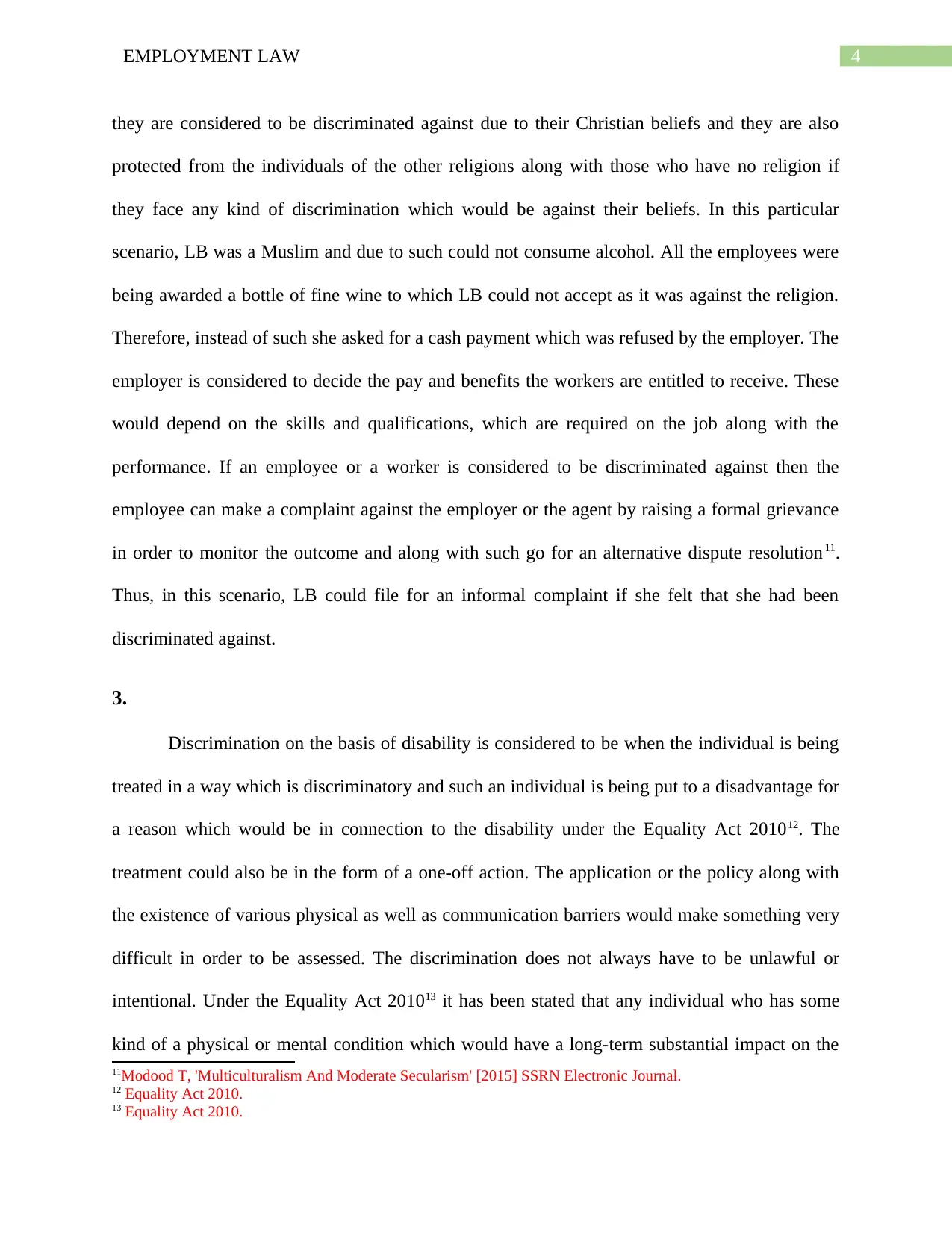
4EMPLOYMENT LAW
they are considered to be discriminated against due to their Christian beliefs and they are also
protected from the individuals of the other religions along with those who have no religion if
they face any kind of discrimination which would be against their beliefs. In this particular
scenario, LB was a Muslim and due to such could not consume alcohol. All the employees were
being awarded a bottle of fine wine to which LB could not accept as it was against the religion.
Therefore, instead of such she asked for a cash payment which was refused by the employer. The
employer is considered to decide the pay and benefits the workers are entitled to receive. These
would depend on the skills and qualifications, which are required on the job along with the
performance. If an employee or a worker is considered to be discriminated against then the
employee can make a complaint against the employer or the agent by raising a formal grievance
in order to monitor the outcome and along with such go for an alternative dispute resolution11.
Thus, in this scenario, LB could file for an informal complaint if she felt that she had been
discriminated against.
3.
Discrimination on the basis of disability is considered to be when the individual is being
treated in a way which is discriminatory and such an individual is being put to a disadvantage for
a reason which would be in connection to the disability under the Equality Act 201012. The
treatment could also be in the form of a one-off action. The application or the policy along with
the existence of various physical as well as communication barriers would make something very
difficult in order to be assessed. The discrimination does not always have to be unlawful or
intentional. Under the Equality Act 201013 it has been stated that any individual who has some
kind of a physical or mental condition which would have a long-term substantial impact on the
11Modood T, 'Multiculturalism And Moderate Secularism' [2015] SSRN Electronic Journal.
12 Equality Act 2010.
13 Equality Act 2010.
they are considered to be discriminated against due to their Christian beliefs and they are also
protected from the individuals of the other religions along with those who have no religion if
they face any kind of discrimination which would be against their beliefs. In this particular
scenario, LB was a Muslim and due to such could not consume alcohol. All the employees were
being awarded a bottle of fine wine to which LB could not accept as it was against the religion.
Therefore, instead of such she asked for a cash payment which was refused by the employer. The
employer is considered to decide the pay and benefits the workers are entitled to receive. These
would depend on the skills and qualifications, which are required on the job along with the
performance. If an employee or a worker is considered to be discriminated against then the
employee can make a complaint against the employer or the agent by raising a formal grievance
in order to monitor the outcome and along with such go for an alternative dispute resolution11.
Thus, in this scenario, LB could file for an informal complaint if she felt that she had been
discriminated against.
3.
Discrimination on the basis of disability is considered to be when the individual is being
treated in a way which is discriminatory and such an individual is being put to a disadvantage for
a reason which would be in connection to the disability under the Equality Act 201012. The
treatment could also be in the form of a one-off action. The application or the policy along with
the existence of various physical as well as communication barriers would make something very
difficult in order to be assessed. The discrimination does not always have to be unlawful or
intentional. Under the Equality Act 201013 it has been stated that any individual who has some
kind of a physical or mental condition which would have a long-term substantial impact on the
11Modood T, 'Multiculturalism And Moderate Secularism' [2015] SSRN Electronic Journal.
12 Equality Act 2010.
13 Equality Act 2010.
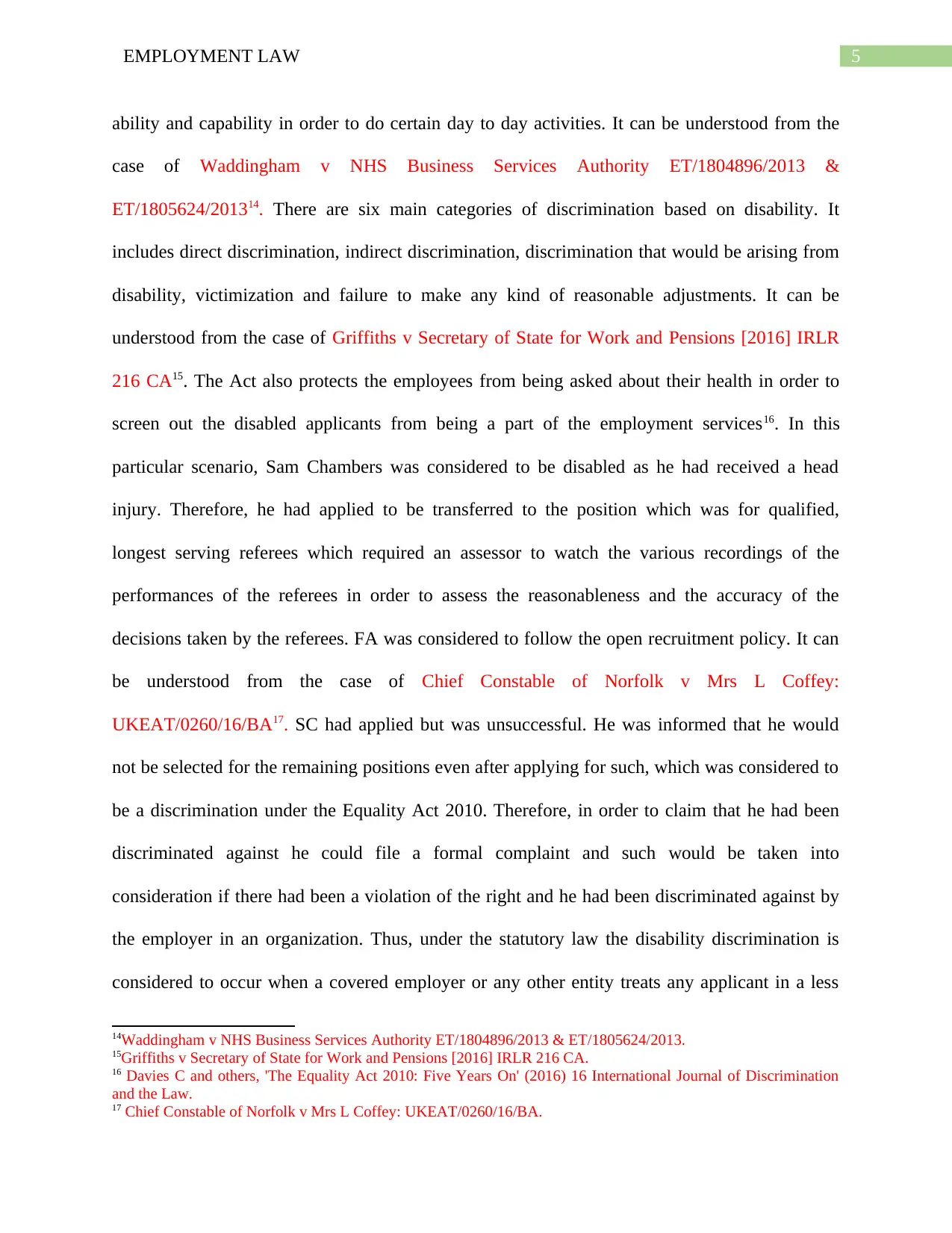
5EMPLOYMENT LAW
ability and capability in order to do certain day to day activities. It can be understood from the
case of Waddingham v NHS Business Services Authority ET/1804896/2013 &
ET/1805624/201314. There are six main categories of discrimination based on disability. It
includes direct discrimination, indirect discrimination, discrimination that would be arising from
disability, victimization and failure to make any kind of reasonable adjustments. It can be
understood from the case of Griffiths v Secretary of State for Work and Pensions [2016] IRLR
216 CA15. The Act also protects the employees from being asked about their health in order to
screen out the disabled applicants from being a part of the employment services16. In this
particular scenario, Sam Chambers was considered to be disabled as he had received a head
injury. Therefore, he had applied to be transferred to the position which was for qualified,
longest serving referees which required an assessor to watch the various recordings of the
performances of the referees in order to assess the reasonableness and the accuracy of the
decisions taken by the referees. FA was considered to follow the open recruitment policy. It can
be understood from the case of Chief Constable of Norfolk v Mrs L Coffey:
UKEAT/0260/16/BA17. SC had applied but was unsuccessful. He was informed that he would
not be selected for the remaining positions even after applying for such, which was considered to
be a discrimination under the Equality Act 2010. Therefore, in order to claim that he had been
discriminated against he could file a formal complaint and such would be taken into
consideration if there had been a violation of the right and he had been discriminated against by
the employer in an organization. Thus, under the statutory law the disability discrimination is
considered to occur when a covered employer or any other entity treats any applicant in a less
14Waddingham v NHS Business Services Authority ET/1804896/2013 & ET/1805624/2013.
15Griffiths v Secretary of State for Work and Pensions [2016] IRLR 216 CA.
16 Davies C and others, 'The Equality Act 2010: Five Years On' (2016) 16 International Journal of Discrimination
and the Law.
17 Chief Constable of Norfolk v Mrs L Coffey: UKEAT/0260/16/BA.
ability and capability in order to do certain day to day activities. It can be understood from the
case of Waddingham v NHS Business Services Authority ET/1804896/2013 &
ET/1805624/201314. There are six main categories of discrimination based on disability. It
includes direct discrimination, indirect discrimination, discrimination that would be arising from
disability, victimization and failure to make any kind of reasonable adjustments. It can be
understood from the case of Griffiths v Secretary of State for Work and Pensions [2016] IRLR
216 CA15. The Act also protects the employees from being asked about their health in order to
screen out the disabled applicants from being a part of the employment services16. In this
particular scenario, Sam Chambers was considered to be disabled as he had received a head
injury. Therefore, he had applied to be transferred to the position which was for qualified,
longest serving referees which required an assessor to watch the various recordings of the
performances of the referees in order to assess the reasonableness and the accuracy of the
decisions taken by the referees. FA was considered to follow the open recruitment policy. It can
be understood from the case of Chief Constable of Norfolk v Mrs L Coffey:
UKEAT/0260/16/BA17. SC had applied but was unsuccessful. He was informed that he would
not be selected for the remaining positions even after applying for such, which was considered to
be a discrimination under the Equality Act 2010. Therefore, in order to claim that he had been
discriminated against he could file a formal complaint and such would be taken into
consideration if there had been a violation of the right and he had been discriminated against by
the employer in an organization. Thus, under the statutory law the disability discrimination is
considered to occur when a covered employer or any other entity treats any applicant in a less
14Waddingham v NHS Business Services Authority ET/1804896/2013 & ET/1805624/2013.
15Griffiths v Secretary of State for Work and Pensions [2016] IRLR 216 CA.
16 Davies C and others, 'The Equality Act 2010: Five Years On' (2016) 16 International Journal of Discrimination
and the Law.
17 Chief Constable of Norfolk v Mrs L Coffey: UKEAT/0260/16/BA.
⊘ This is a preview!⊘
Do you want full access?
Subscribe today to unlock all pages.

Trusted by 1+ million students worldwide
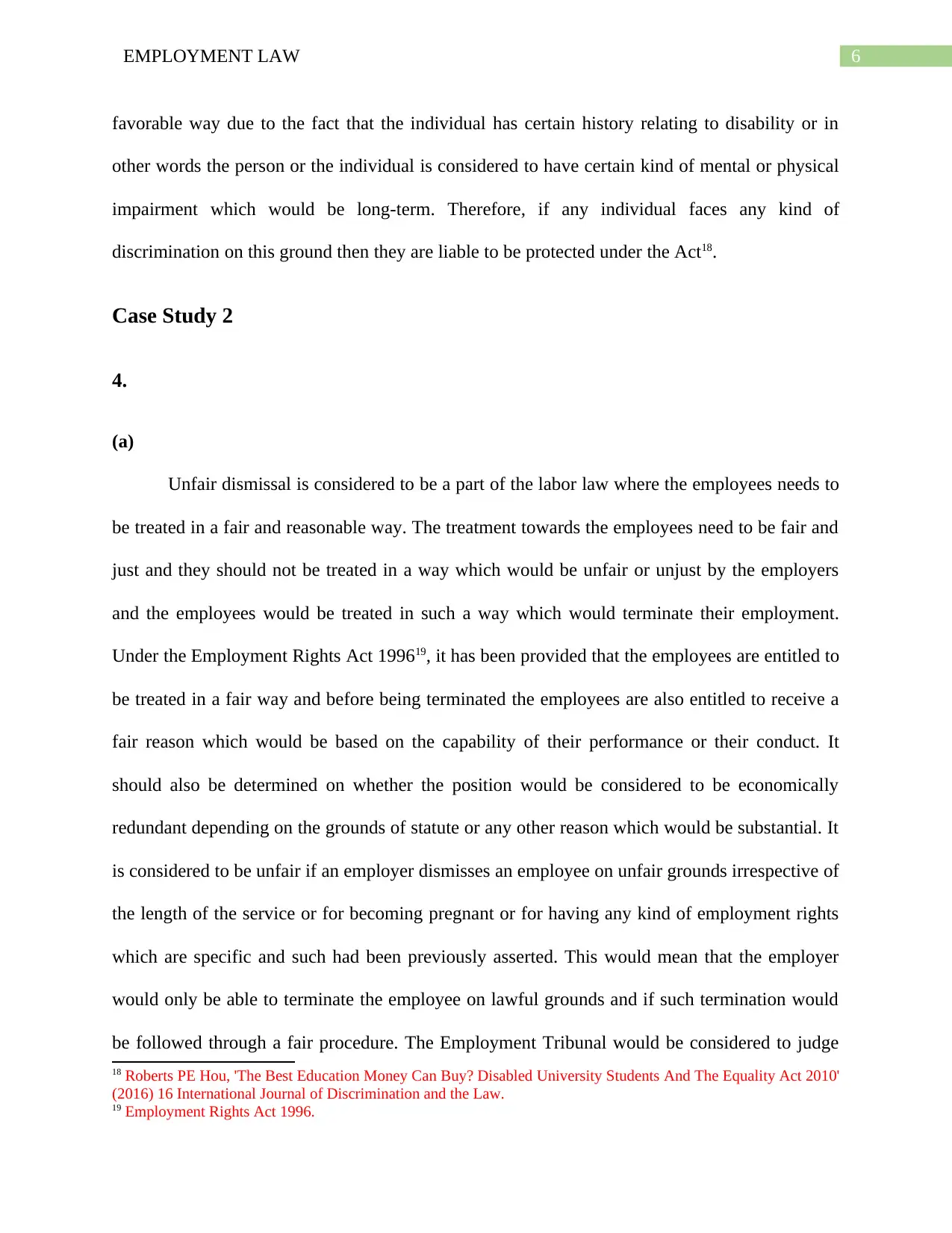
6EMPLOYMENT LAW
favorable way due to the fact that the individual has certain history relating to disability or in
other words the person or the individual is considered to have certain kind of mental or physical
impairment which would be long-term. Therefore, if any individual faces any kind of
discrimination on this ground then they are liable to be protected under the Act18.
Case Study 2
4.
(a)
Unfair dismissal is considered to be a part of the labor law where the employees needs to
be treated in a fair and reasonable way. The treatment towards the employees need to be fair and
just and they should not be treated in a way which would be unfair or unjust by the employers
and the employees would be treated in such a way which would terminate their employment.
Under the Employment Rights Act 199619, it has been provided that the employees are entitled to
be treated in a fair way and before being terminated the employees are also entitled to receive a
fair reason which would be based on the capability of their performance or their conduct. It
should also be determined on whether the position would be considered to be economically
redundant depending on the grounds of statute or any other reason which would be substantial. It
is considered to be unfair if an employer dismisses an employee on unfair grounds irrespective of
the length of the service or for becoming pregnant or for having any kind of employment rights
which are specific and such had been previously asserted. This would mean that the employer
would only be able to terminate the employee on lawful grounds and if such termination would
be followed through a fair procedure. The Employment Tribunal would be considered to judge
18 Roberts PE Hou, 'The Best Education Money Can Buy? Disabled University Students And The Equality Act 2010'
(2016) 16 International Journal of Discrimination and the Law.
19 Employment Rights Act 1996.
favorable way due to the fact that the individual has certain history relating to disability or in
other words the person or the individual is considered to have certain kind of mental or physical
impairment which would be long-term. Therefore, if any individual faces any kind of
discrimination on this ground then they are liable to be protected under the Act18.
Case Study 2
4.
(a)
Unfair dismissal is considered to be a part of the labor law where the employees needs to
be treated in a fair and reasonable way. The treatment towards the employees need to be fair and
just and they should not be treated in a way which would be unfair or unjust by the employers
and the employees would be treated in such a way which would terminate their employment.
Under the Employment Rights Act 199619, it has been provided that the employees are entitled to
be treated in a fair way and before being terminated the employees are also entitled to receive a
fair reason which would be based on the capability of their performance or their conduct. It
should also be determined on whether the position would be considered to be economically
redundant depending on the grounds of statute or any other reason which would be substantial. It
is considered to be unfair if an employer dismisses an employee on unfair grounds irrespective of
the length of the service or for becoming pregnant or for having any kind of employment rights
which are specific and such had been previously asserted. This would mean that the employer
would only be able to terminate the employee on lawful grounds and if such termination would
be followed through a fair procedure. The Employment Tribunal would be considered to judge
18 Roberts PE Hou, 'The Best Education Money Can Buy? Disabled University Students And The Equality Act 2010'
(2016) 16 International Journal of Discrimination and the Law.
19 Employment Rights Act 1996.
Paraphrase This Document
Need a fresh take? Get an instant paraphrase of this document with our AI Paraphraser
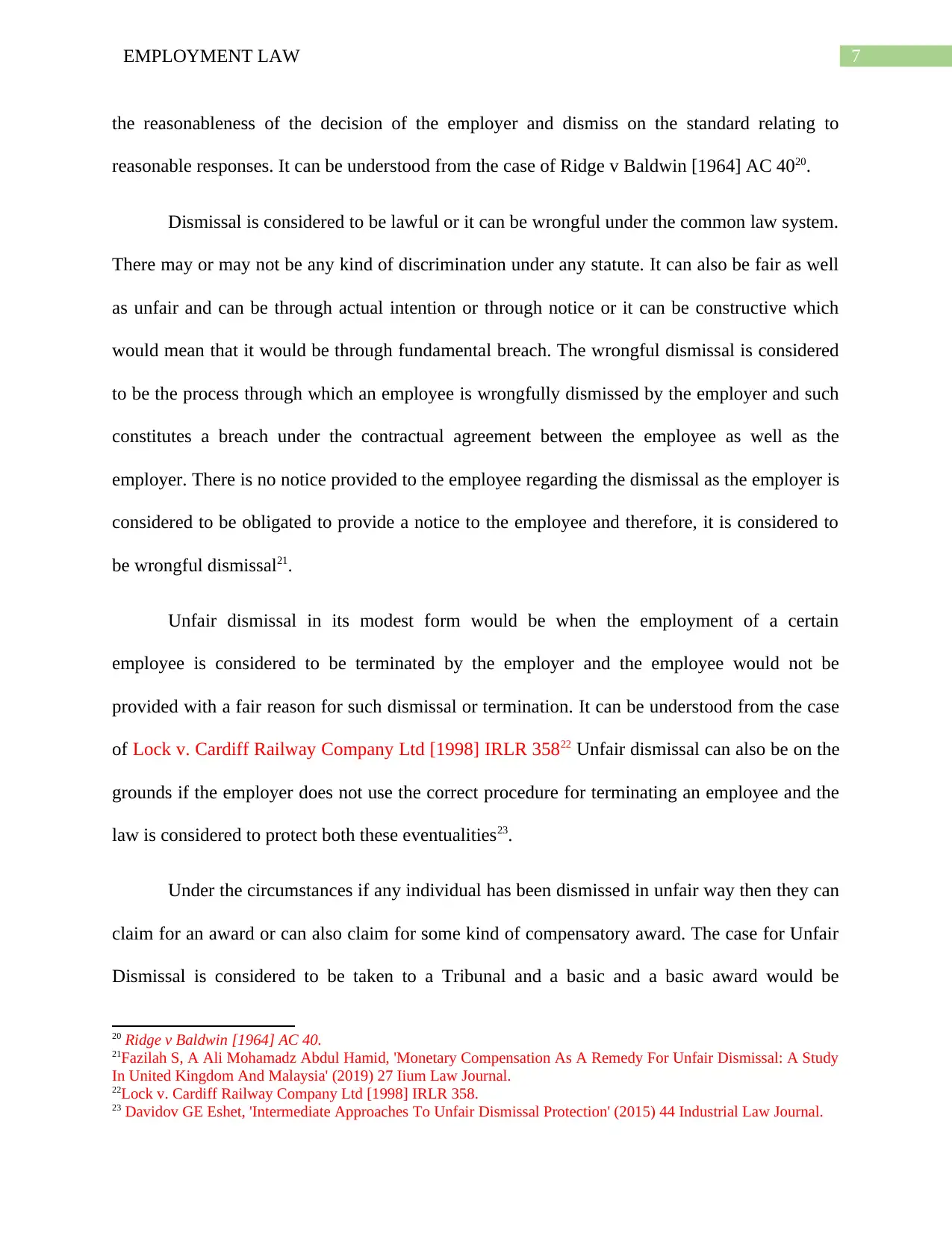
7EMPLOYMENT LAW
the reasonableness of the decision of the employer and dismiss on the standard relating to
reasonable responses. It can be understood from the case of Ridge v Baldwin [1964] AC 4020.
Dismissal is considered to be lawful or it can be wrongful under the common law system.
There may or may not be any kind of discrimination under any statute. It can also be fair as well
as unfair and can be through actual intention or through notice or it can be constructive which
would mean that it would be through fundamental breach. The wrongful dismissal is considered
to be the process through which an employee is wrongfully dismissed by the employer and such
constitutes a breach under the contractual agreement between the employee as well as the
employer. There is no notice provided to the employee regarding the dismissal as the employer is
considered to be obligated to provide a notice to the employee and therefore, it is considered to
be wrongful dismissal21.
Unfair dismissal in its modest form would be when the employment of a certain
employee is considered to be terminated by the employer and the employee would not be
provided with a fair reason for such dismissal or termination. It can be understood from the case
of Lock v. Cardiff Railway Company Ltd [1998] IRLR 35822 Unfair dismissal can also be on the
grounds if the employer does not use the correct procedure for terminating an employee and the
law is considered to protect both these eventualities23.
Under the circumstances if any individual has been dismissed in unfair way then they can
claim for an award or can also claim for some kind of compensatory award. The case for Unfair
Dismissal is considered to be taken to a Tribunal and a basic and a basic award would be
20 Ridge v Baldwin [1964] AC 40.
21Fazilah S, A Ali Mohamadz Abdul Hamid, 'Monetary Compensation As A Remedy For Unfair Dismissal: A Study
In United Kingdom And Malaysia' (2019) 27 Iium Law Journal.
22Lock v. Cardiff Railway Company Ltd [1998] IRLR 358.
23 Davidov GE Eshet, 'Intermediate Approaches To Unfair Dismissal Protection' (2015) 44 Industrial Law Journal.
the reasonableness of the decision of the employer and dismiss on the standard relating to
reasonable responses. It can be understood from the case of Ridge v Baldwin [1964] AC 4020.
Dismissal is considered to be lawful or it can be wrongful under the common law system.
There may or may not be any kind of discrimination under any statute. It can also be fair as well
as unfair and can be through actual intention or through notice or it can be constructive which
would mean that it would be through fundamental breach. The wrongful dismissal is considered
to be the process through which an employee is wrongfully dismissed by the employer and such
constitutes a breach under the contractual agreement between the employee as well as the
employer. There is no notice provided to the employee regarding the dismissal as the employer is
considered to be obligated to provide a notice to the employee and therefore, it is considered to
be wrongful dismissal21.
Unfair dismissal in its modest form would be when the employment of a certain
employee is considered to be terminated by the employer and the employee would not be
provided with a fair reason for such dismissal or termination. It can be understood from the case
of Lock v. Cardiff Railway Company Ltd [1998] IRLR 35822 Unfair dismissal can also be on the
grounds if the employer does not use the correct procedure for terminating an employee and the
law is considered to protect both these eventualities23.
Under the circumstances if any individual has been dismissed in unfair way then they can
claim for an award or can also claim for some kind of compensatory award. The case for Unfair
Dismissal is considered to be taken to a Tribunal and a basic and a basic award would be
20 Ridge v Baldwin [1964] AC 40.
21Fazilah S, A Ali Mohamadz Abdul Hamid, 'Monetary Compensation As A Remedy For Unfair Dismissal: A Study
In United Kingdom And Malaysia' (2019) 27 Iium Law Journal.
22Lock v. Cardiff Railway Company Ltd [1998] IRLR 358.
23 Davidov GE Eshet, 'Intermediate Approaches To Unfair Dismissal Protection' (2015) 44 Industrial Law Journal.
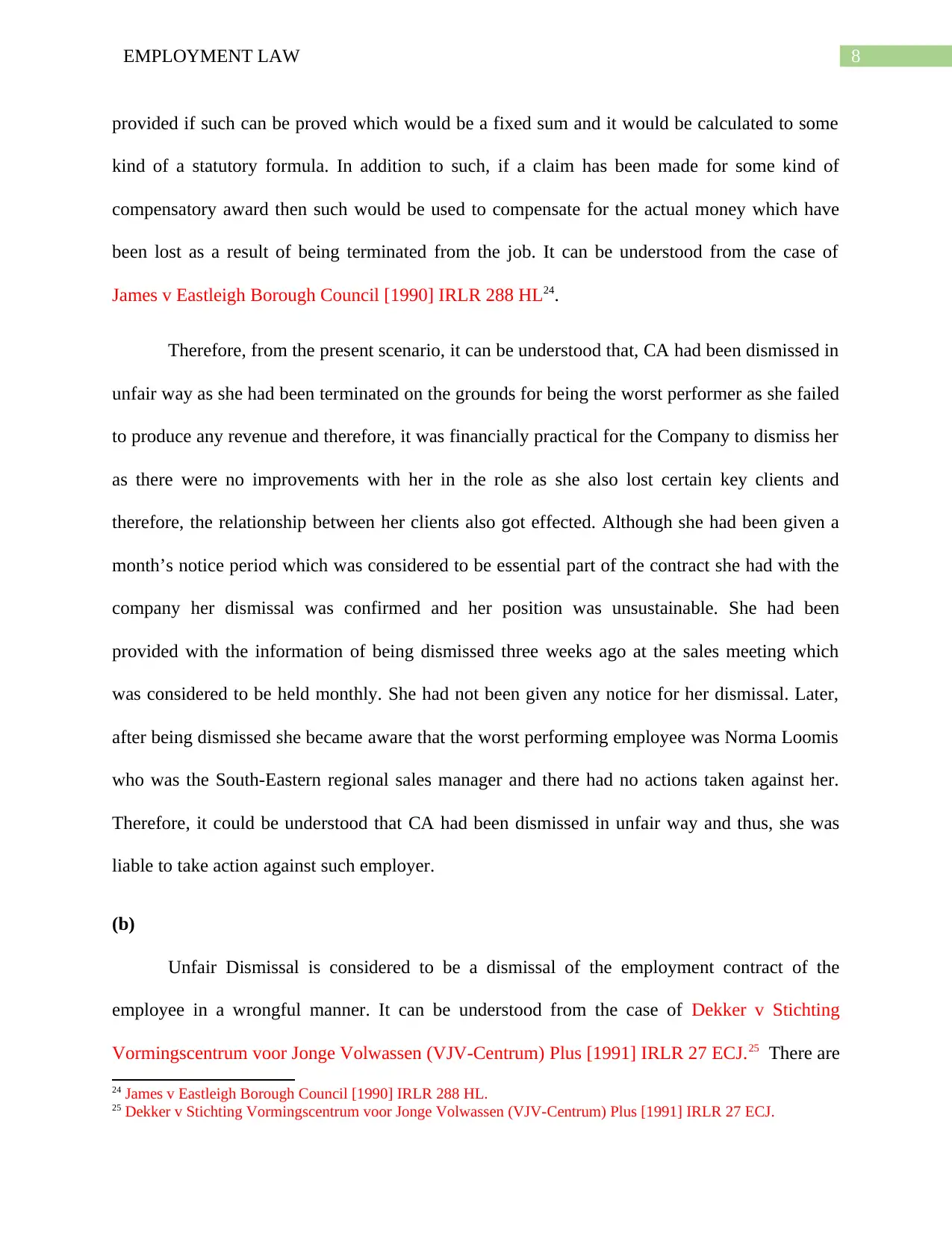
8EMPLOYMENT LAW
provided if such can be proved which would be a fixed sum and it would be calculated to some
kind of a statutory formula. In addition to such, if a claim has been made for some kind of
compensatory award then such would be used to compensate for the actual money which have
been lost as a result of being terminated from the job. It can be understood from the case of
James v Eastleigh Borough Council [1990] IRLR 288 HL24.
Therefore, from the present scenario, it can be understood that, CA had been dismissed in
unfair way as she had been terminated on the grounds for being the worst performer as she failed
to produce any revenue and therefore, it was financially practical for the Company to dismiss her
as there were no improvements with her in the role as she also lost certain key clients and
therefore, the relationship between her clients also got effected. Although she had been given a
month’s notice period which was considered to be essential part of the contract she had with the
company her dismissal was confirmed and her position was unsustainable. She had been
provided with the information of being dismissed three weeks ago at the sales meeting which
was considered to be held monthly. She had not been given any notice for her dismissal. Later,
after being dismissed she became aware that the worst performing employee was Norma Loomis
who was the South-Eastern regional sales manager and there had no actions taken against her.
Therefore, it could be understood that CA had been dismissed in unfair way and thus, she was
liable to take action against such employer.
(b)
Unfair Dismissal is considered to be a dismissal of the employment contract of the
employee in a wrongful manner. It can be understood from the case of Dekker v Stichting
Vormingscentrum voor Jonge Volwassen (VJV-Centrum) Plus [1991] IRLR 27 ECJ.25 There are
24 James v Eastleigh Borough Council [1990] IRLR 288 HL.
25 Dekker v Stichting Vormingscentrum voor Jonge Volwassen (VJV-Centrum) Plus [1991] IRLR 27 ECJ.
provided if such can be proved which would be a fixed sum and it would be calculated to some
kind of a statutory formula. In addition to such, if a claim has been made for some kind of
compensatory award then such would be used to compensate for the actual money which have
been lost as a result of being terminated from the job. It can be understood from the case of
James v Eastleigh Borough Council [1990] IRLR 288 HL24.
Therefore, from the present scenario, it can be understood that, CA had been dismissed in
unfair way as she had been terminated on the grounds for being the worst performer as she failed
to produce any revenue and therefore, it was financially practical for the Company to dismiss her
as there were no improvements with her in the role as she also lost certain key clients and
therefore, the relationship between her clients also got effected. Although she had been given a
month’s notice period which was considered to be essential part of the contract she had with the
company her dismissal was confirmed and her position was unsustainable. She had been
provided with the information of being dismissed three weeks ago at the sales meeting which
was considered to be held monthly. She had not been given any notice for her dismissal. Later,
after being dismissed she became aware that the worst performing employee was Norma Loomis
who was the South-Eastern regional sales manager and there had no actions taken against her.
Therefore, it could be understood that CA had been dismissed in unfair way and thus, she was
liable to take action against such employer.
(b)
Unfair Dismissal is considered to be a dismissal of the employment contract of the
employee in a wrongful manner. It can be understood from the case of Dekker v Stichting
Vormingscentrum voor Jonge Volwassen (VJV-Centrum) Plus [1991] IRLR 27 ECJ.25 There are
24 James v Eastleigh Borough Council [1990] IRLR 288 HL.
25 Dekker v Stichting Vormingscentrum voor Jonge Volwassen (VJV-Centrum) Plus [1991] IRLR 27 ECJ.
⊘ This is a preview!⊘
Do you want full access?
Subscribe today to unlock all pages.

Trusted by 1+ million students worldwide
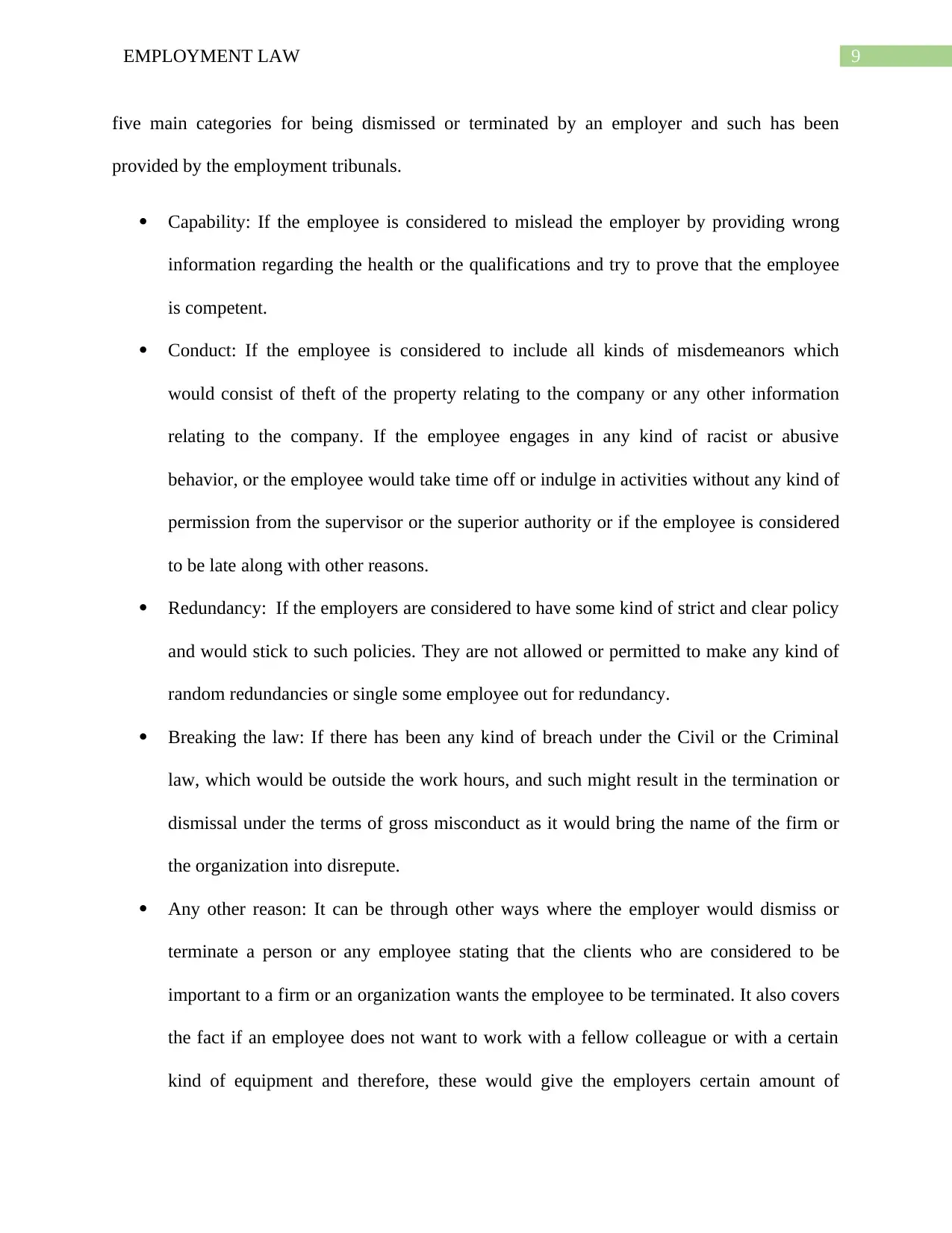
9EMPLOYMENT LAW
five main categories for being dismissed or terminated by an employer and such has been
provided by the employment tribunals.
Capability: If the employee is considered to mislead the employer by providing wrong
information regarding the health or the qualifications and try to prove that the employee
is competent.
Conduct: If the employee is considered to include all kinds of misdemeanors which
would consist of theft of the property relating to the company or any other information
relating to the company. If the employee engages in any kind of racist or abusive
behavior, or the employee would take time off or indulge in activities without any kind of
permission from the supervisor or the superior authority or if the employee is considered
to be late along with other reasons.
Redundancy: If the employers are considered to have some kind of strict and clear policy
and would stick to such policies. They are not allowed or permitted to make any kind of
random redundancies or single some employee out for redundancy.
Breaking the law: If there has been any kind of breach under the Civil or the Criminal
law, which would be outside the work hours, and such might result in the termination or
dismissal under the terms of gross misconduct as it would bring the name of the firm or
the organization into disrepute.
Any other reason: It can be through other ways where the employer would dismiss or
terminate a person or any employee stating that the clients who are considered to be
important to a firm or an organization wants the employee to be terminated. It also covers
the fact if an employee does not want to work with a fellow colleague or with a certain
kind of equipment and therefore, these would give the employers certain amount of
five main categories for being dismissed or terminated by an employer and such has been
provided by the employment tribunals.
Capability: If the employee is considered to mislead the employer by providing wrong
information regarding the health or the qualifications and try to prove that the employee
is competent.
Conduct: If the employee is considered to include all kinds of misdemeanors which
would consist of theft of the property relating to the company or any other information
relating to the company. If the employee engages in any kind of racist or abusive
behavior, or the employee would take time off or indulge in activities without any kind of
permission from the supervisor or the superior authority or if the employee is considered
to be late along with other reasons.
Redundancy: If the employers are considered to have some kind of strict and clear policy
and would stick to such policies. They are not allowed or permitted to make any kind of
random redundancies or single some employee out for redundancy.
Breaking the law: If there has been any kind of breach under the Civil or the Criminal
law, which would be outside the work hours, and such might result in the termination or
dismissal under the terms of gross misconduct as it would bring the name of the firm or
the organization into disrepute.
Any other reason: It can be through other ways where the employer would dismiss or
terminate a person or any employee stating that the clients who are considered to be
important to a firm or an organization wants the employee to be terminated. It also covers
the fact if an employee does not want to work with a fellow colleague or with a certain
kind of equipment and therefore, these would give the employers certain amount of
Paraphrase This Document
Need a fresh take? Get an instant paraphrase of this document with our AI Paraphraser
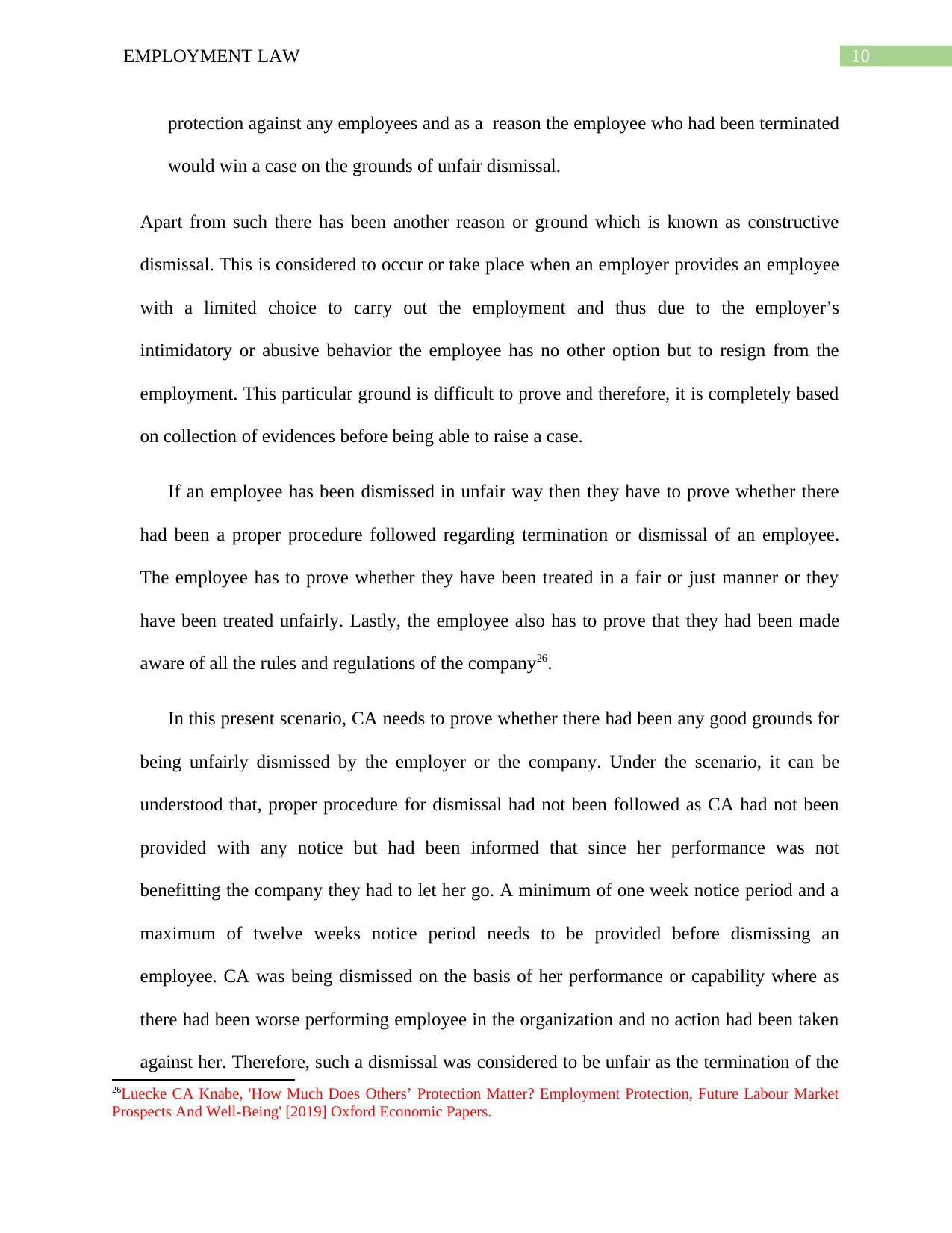
10EMPLOYMENT LAW
protection against any employees and as a reason the employee who had been terminated
would win a case on the grounds of unfair dismissal.
Apart from such there has been another reason or ground which is known as constructive
dismissal. This is considered to occur or take place when an employer provides an employee
with a limited choice to carry out the employment and thus due to the employer’s
intimidatory or abusive behavior the employee has no other option but to resign from the
employment. This particular ground is difficult to prove and therefore, it is completely based
on collection of evidences before being able to raise a case.
If an employee has been dismissed in unfair way then they have to prove whether there
had been a proper procedure followed regarding termination or dismissal of an employee.
The employee has to prove whether they have been treated in a fair or just manner or they
have been treated unfairly. Lastly, the employee also has to prove that they had been made
aware of all the rules and regulations of the company26.
In this present scenario, CA needs to prove whether there had been any good grounds for
being unfairly dismissed by the employer or the company. Under the scenario, it can be
understood that, proper procedure for dismissal had not been followed as CA had not been
provided with any notice but had been informed that since her performance was not
benefitting the company they had to let her go. A minimum of one week notice period and a
maximum of twelve weeks notice period needs to be provided before dismissing an
employee. CA was being dismissed on the basis of her performance or capability where as
there had been worse performing employee in the organization and no action had been taken
against her. Therefore, such a dismissal was considered to be unfair as the termination of the
26Luecke CA Knabe, 'How Much Does Others’ Protection Matter? Employment Protection, Future Labour Market
Prospects And Well-Being' [2019] Oxford Economic Papers.
protection against any employees and as a reason the employee who had been terminated
would win a case on the grounds of unfair dismissal.
Apart from such there has been another reason or ground which is known as constructive
dismissal. This is considered to occur or take place when an employer provides an employee
with a limited choice to carry out the employment and thus due to the employer’s
intimidatory or abusive behavior the employee has no other option but to resign from the
employment. This particular ground is difficult to prove and therefore, it is completely based
on collection of evidences before being able to raise a case.
If an employee has been dismissed in unfair way then they have to prove whether there
had been a proper procedure followed regarding termination or dismissal of an employee.
The employee has to prove whether they have been treated in a fair or just manner or they
have been treated unfairly. Lastly, the employee also has to prove that they had been made
aware of all the rules and regulations of the company26.
In this present scenario, CA needs to prove whether there had been any good grounds for
being unfairly dismissed by the employer or the company. Under the scenario, it can be
understood that, proper procedure for dismissal had not been followed as CA had not been
provided with any notice but had been informed that since her performance was not
benefitting the company they had to let her go. A minimum of one week notice period and a
maximum of twelve weeks notice period needs to be provided before dismissing an
employee. CA was being dismissed on the basis of her performance or capability where as
there had been worse performing employee in the organization and no action had been taken
against her. Therefore, such a dismissal was considered to be unfair as the termination of the
26Luecke CA Knabe, 'How Much Does Others’ Protection Matter? Employment Protection, Future Labour Market
Prospects And Well-Being' [2019] Oxford Economic Papers.
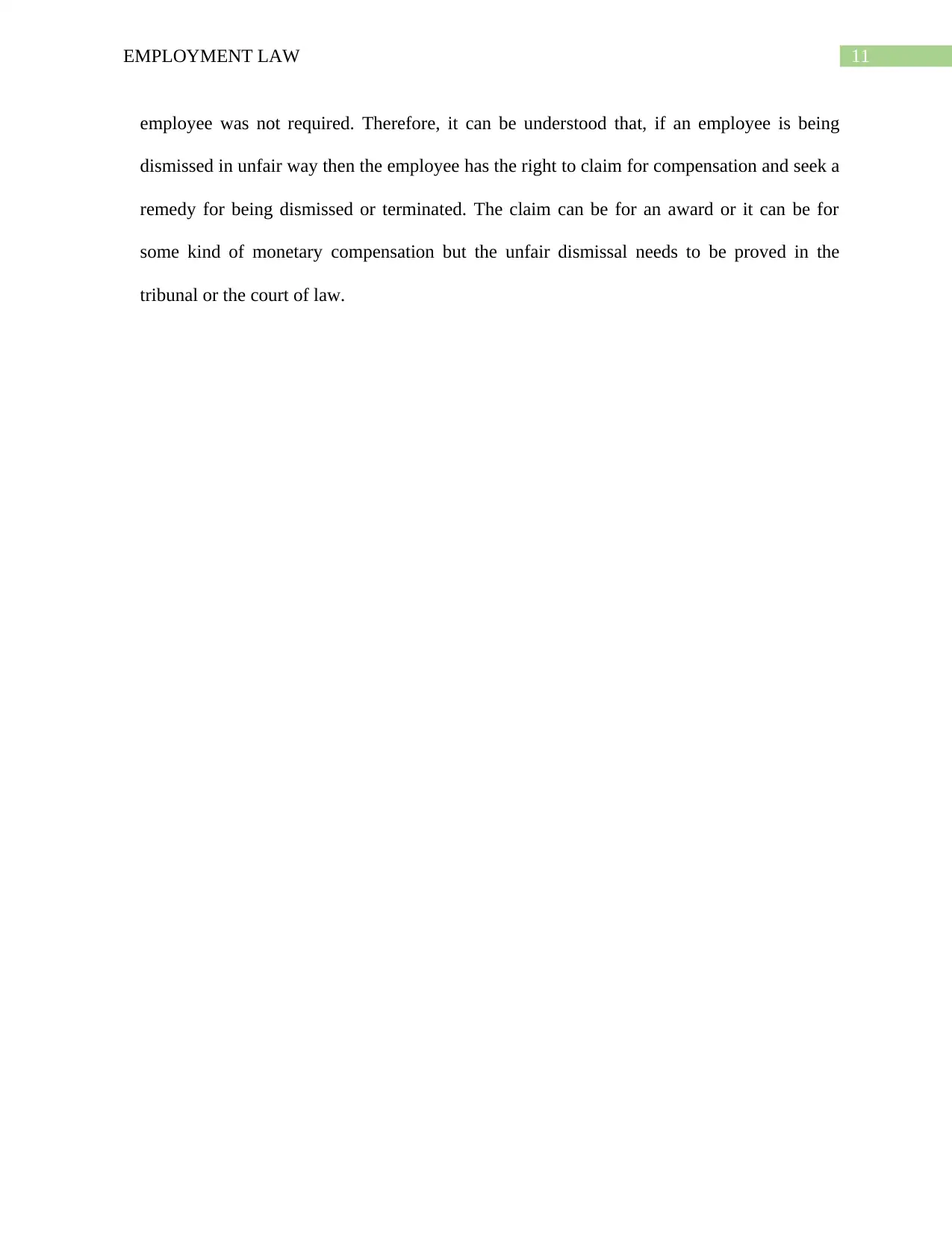
11EMPLOYMENT LAW
employee was not required. Therefore, it can be understood that, if an employee is being
dismissed in unfair way then the employee has the right to claim for compensation and seek a
remedy for being dismissed or terminated. The claim can be for an award or it can be for
some kind of monetary compensation but the unfair dismissal needs to be proved in the
tribunal or the court of law.
employee was not required. Therefore, it can be understood that, if an employee is being
dismissed in unfair way then the employee has the right to claim for compensation and seek a
remedy for being dismissed or terminated. The claim can be for an award or it can be for
some kind of monetary compensation but the unfair dismissal needs to be proved in the
tribunal or the court of law.
⊘ This is a preview!⊘
Do you want full access?
Subscribe today to unlock all pages.

Trusted by 1+ million students worldwide
1 out of 14
Related Documents
Your All-in-One AI-Powered Toolkit for Academic Success.
+13062052269
info@desklib.com
Available 24*7 on WhatsApp / Email
![[object Object]](/_next/static/media/star-bottom.7253800d.svg)
Unlock your academic potential
Copyright © 2020–2025 A2Z Services. All Rights Reserved. Developed and managed by ZUCOL.





